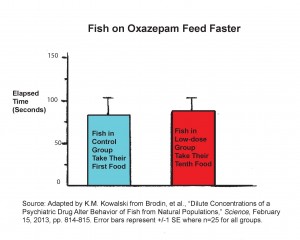By Kathiann M. Kowalski
Could mood-altering drugs force Great Lakes fish into a feeding frenzy?

A graph demonstrating that fish given a low dose of Oxazepam feed faster than those in the control group. Graphic: Kathiann M. Kowalski.
A new study from Sweden’s UmeÃ¥ University finds that fish eat faster and become bolder when exposed to a common anti-anxiety drug. That poses serious questions for the Great Lakes, where the presence of pharmaceuticals has been documented.
In the study, published last week in Science, researchers dosed European wild perch with oxazepam. Small amounts of the medication pass from patients’ urine into wastewater. Sewage treatment rarely removes pharmaceuticals from wastewater before they enter rivers and streams.
Like other anti-anxiety drugs, oxazepam alters people’s mood and behavior. It also affects fish behavior. The UmeÃ¥ researchers exposed perch to low and high doses of the drug. Both groups ate significantly faster than a control group. They also became bolder and less sociable.
When asked about the study, U.S. Environmental Protection Agency officials questioned its relevance to the real world. The agency noted that the low-dose level was twice the level found in Swedish wastewater plant discharge. Nonetheless, study co-author Jerker Fick says, “We see a very strong, statistically significant effect at these levels. This is by no means the no-effect concentration.”
It could happen here
Oxazempam targets the brain’s receptors of a chemical messenger that reduces neurons’ activity. The receptors are present in almost all vertebrates.
“So all fish–perch in the Great Lakes and others–have these drug targets,” says Fick.
Oxazepam’s effects could present “grave consequences” for ecosystems, says study co-author Tomas Brodin. If fish eat more zooplankton, they could pave the way for algae blooms. And bolder, less sociable fish could stray from schools, increasing the risk of becoming another species’ supper.
“Start with a top-down effect, and once those things at the bottom of the food chain would change, it would trickle back up,” says Steve Mauro, a biologist at Mercyhurst University near Lake Erie. Predicting precise changes is difficult.
A 2012 report by the Alliance for the Great Lakes, a nonprofit organization dedicated to conserving and restoring the Great Lakes, echoes concerns about a drugged ecosystem. “Concentrations of these chemicals would tend to be higher in the nearshore areas, especially close to where wastewater effluents are being discharged,” says Olga Lyandres, the report’s author. “Nearshore areas are where a lot of spawning habitats are, so there’s a higher chance that the fish may be exposed.”
Drugs could stay in Great Lakes waters for a long time. Discharge points are all around the shore, but mixing in the middle occurs slowly. For Lake Michigan, says Lyandres, “It takes a century for the water to cycle through the lake.”
More drugs, more effects
Scientists in the Great Lakes region already know that another mood-altering drug, fluoxetine, affects fish behavior. Fluoxetine is the generic version of the anti-depressant Prozac.

Pharmaceutical drugs in the Great Lakes can inhibit reproduction of fish, impact water quality and harm the ecosystem. Photo: Kathiann M. Kowalski.
Fathead minnows normally follow an elaborate nesting and mating ritual. “This whole dance gets disrupted” when the fish are exposed to fluoxetine, says Rebecca Klaper at the University of Wisconsin–Milwaukee’s School of Freshwater Sciences. Lower libido is a possible side effect for humans, too.
Disrupting reproduction could lead to fewer fish. The fathead minnow is often used in toxicology studies because drugs that disturb them likely affect other fish, Klaper says
Fluoxetine can also kill E. coli and other bacteria at the bottom of the food chain, reports Mauro. “Without bacteria, you have less overall phytoplankton, and you have less food sources for those other organisms.”
Fewer bacteria could also confound water quality assessments. “We may think it’s safe water when in fact it has a bunch of chemicals in it,” says Mauro.
Of course, these medicines aren’t the only ones out there. U.S. Geological Survey hydrologist Kathy Lee and other scientists have found “a broad scope” of prescription and over-the-counter drugs in waters of the Great Lakes region. “It’s not surprising, given that people take medications and excrete them,” Lee says.
Those drugs’ effects can vary widely. For example, birth control pills and other hormones could disrupt endocrine systems. In some cases, fish develop both male and female characteristics, notes Klaper.
Antibiotics also cause concern. “They might be screwing up the bacterial communities and might cause increased antibiotic resistance,” Klaper says. Common cholesterol medicines and other drugs add to the brew. “It’s a very low concentration soup–but a soup out there of chemicals,” says Klaper.
Low concentrations of such chemicals may interact with each other in unexpected ways. One of Mauro’s experiments combined fluoxetine with triclosan–the active ingredient in many bacterial products. Together, they were “much more effective at killing microbes” than either one alone.
“We probably don’t want to panic just yet,” says Mauro. “But it’s really good that we are being proactive and taking a look at these things.” Learning more about low-dose drug impacts now can help set priorities for better sewage treatment in the future.
Brodin’s team, along with another Swedish scientist, has just published a follow-up study, in which they found lower mortality among perch fry exposed to the same drug during embryonic development. The new research does not negate their February 2013 study, although the authors question whether the scope of issues considered by risk assessment studies should include possible therapeutic effects too. To find out more, see my blog post at http://tinyurl.com/p2pckbb. The post includes hyperlinks to the new study.
A most interesting study, but more extensive other studies need to be done.
Thanks for your comment, Doug. Here’s what I found out relevant to your questions:
1. Yes, species of perch are different. Nonetheless, they all have the GABA receptors. Thus, as noted in the article, Dr. Fick felt that perch in the Great Lakes and other fish would also be affected by the drug. Dr. Mauro also told me that, if one type of fish shows an effect in one study, “The implication is that it probably extends to a whole sweep of different kinds of fish.”
2. Where species of fish would likely differ is in how much of a drug they’d need in order to show an effect. This is similar to how the dose-response relationship often works in people: Larger people may need a larger dose in order for a drug to affect them. Interestingly, Dr. Brodin also suggested that oxazepam’s effects may depend in part on how anxious fish are in the first place. It’s possible that smaller fish who are more fearful of getting eaten might respond more to the drug than a larger fish that has fewer worries about predators.
3. The low dose used in the Swedish experiment was about twice that of levels found in Swedish wastewater discharges. The change in feeding behavior at that level was rather marked: As the graph shows, by the time the control group fish took their first zooplankton, fish in the low-dose group had almost finished ten. This was NOT the no-effect level, meaning that effects could be expected at smaller doses too. Moreover, the Swedish study was examining only oxazepam. Out in the real world, fish are exposed to a whole mix of chemicals, so the thresholds needed for effects may be smaller.
4. Last but not least, yes, oxazepam does seem to bioaccumulate. Muscle tissue from perch in one Swedish river had more than six times the level of that in the water itself.
There are three members of Percidae (perch) family in Europe.
One, and perhaps the one in the Swedish study, is the European Perch, which more closely resembles our Walleye in size than it does our familiar Yellow Perch.
Another, the Zander, is more similar to our Northern Pike (which is not in the perch family.
Both are popular game fish in Europe.
The third is the Ruffe, which, as you may know, have been found in Lake Superior and is potentially an invasive threat.
The European Perch has been introduced in many areas, including the southern hemisphere, where it has proved to be quite invasive. So, we don’t want them in our waters no matter how excited anglers may get about them as potential new game fish.
The article suggests that our native perch may respond similarly to drugs to how European perch do. It’s not clear if something special about the Percidae is important in this response to drugs, and it does not seem clear that our perch and European perch would respond in the same way.
It is also not clear how closely “dosing” perch with drugs resembles exposing them to drugs in a natural environment. Are these drugs bioaccumulative?
Many questions to be answered…
This again points out, the biggest threat to the Great Lakes is the first invasive species. The white guys from out of town, that my friends would be us!